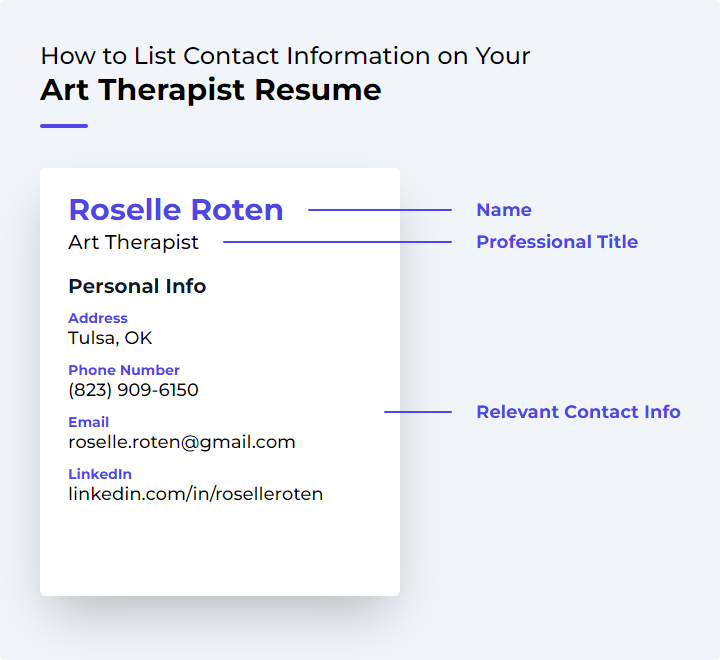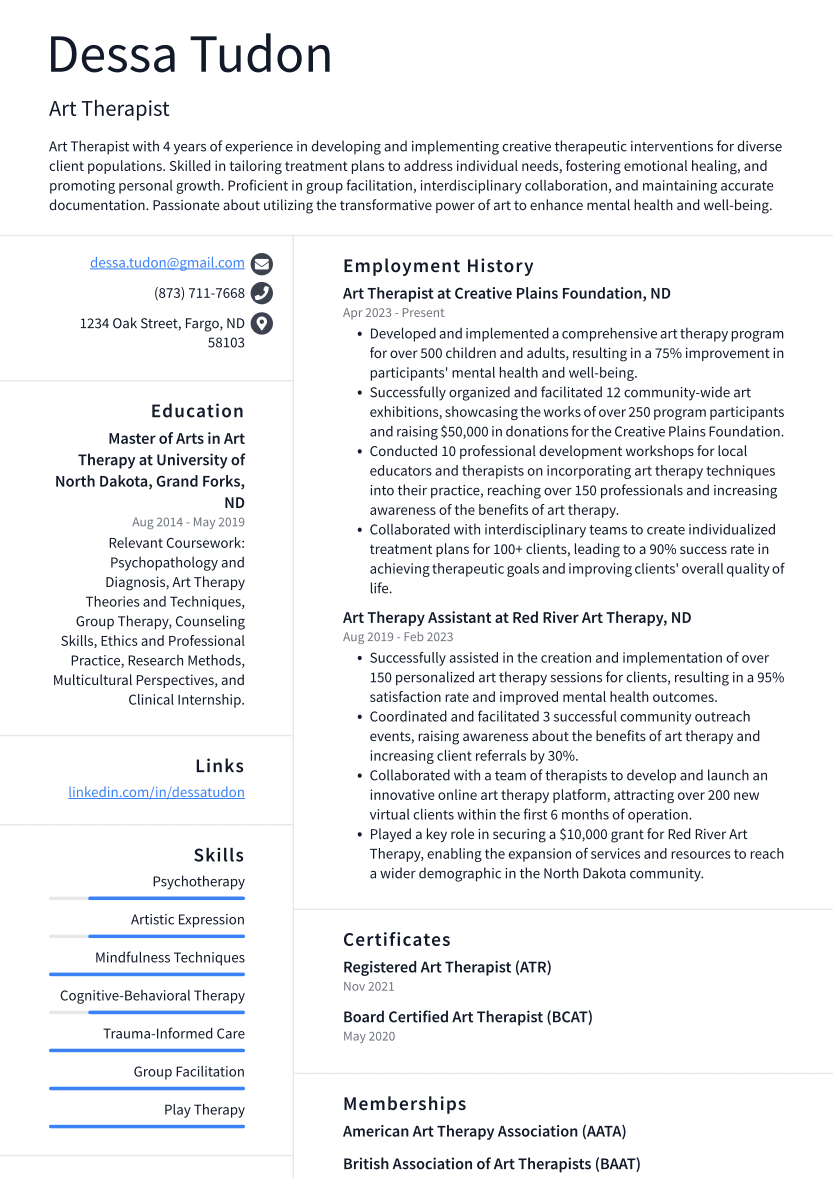Art Therapist Resume Examples
Writing a great art therapist resume is important because it is one of the first things a potential employer will see when they are considering you for a position. It is your opportunity to make a good first impression and sell yourself as the best candidate for the job.
Create your resume
Select from 7 professional resume templates
If you're looking for inspiration when it comes to drafting your own art therapist resume, look no further than the samples below. These resumes will help you highlight your experience and qualifications in the most effective way possible, giving you the best chance of landing the art therapist job you're after.
Essential Components of an Art Therapist Resume
A compelling Art Therapist resume is essential for showcasing your expertise, professional journey, and unique attributes to prospective employers. It's more than a career summary; it's a testament to your understanding of art's therapeutic value and its impact on client well-being. A well-crafted resume includes several key elements that collectively present a holistic view of your capabilities as an Art Therapist. Below, we'll explore these elements, discuss their significance, and offer tips to enhance each section.
1. Contact Information
Ensure your contact information is prominent—typically at the top of your resume. This section should include your full name, phone number, and professional email address. Ensure your voicemail is professional and your email address uses a combination of your first and last names for a polished look.

Include links to your LinkedIn profile or professional website showcasing your art therapy work. Ensure all online profiles are up-to-date and reflect positively on you. Only include your home address if specifically requested by the employer.
Tip: This section is crucial for enabling employers to contact you for further discussions or interviews.
2. Objective Statement
Your resume's objective statement is a concise paragraph that conveys your career goals, skills, and qualifications. It's the first thing employers see, so make it engaging. Use this space to express your passion for art therapy and your intent to contribute positively to the organization.
Customize your objective statement for each job application, aligning your professional objectives with the employer's needs as outlined in the job description. Highlight your understanding of art therapy principles and showcase any specialties you have.
Example: "Dedicated Art Therapist with over five years of experience in creative therapeutic techniques for mental health, specializing in aiding children affected by trauma. Eager to contribute to XYZ Health Center to enhance patient well-being."
Related: Top Art Therapist Resume Objective Examples
3. Education and Certifications
Detail your educational background and any professional certifications in the "Education and Certifications" section. Highlight your bachelor's degree, relevant coursework, and any graduate degrees in art therapy or related fields. Include the institutions, graduation dates, and honors received.
In the U.S., board certification from the Art Therapy Credentials Board (ATCB) is often required. List any additional training or certifications that complement your art therapy practice.
Tip: Keep this section updated and concise, allowing employers to quickly verify your qualifications.
Related: Art Therapist Certifications
4. Relevant Work Experience
The "Relevant Work Experience" section is where you showcase your professional history and hands-on experience. List previous positions, the scope of work, and notable achievements, focusing on roles where you utilized art therapy techniques.
For each position, include:
- Job title
- Employer's name and location
- Dates of employment
- Key responsibilities and accomplishments
Highlight any innovative therapeutic strategies you've developed, successes in client outcomes, and experiences with diverse client groups. Quantify achievements where possible and include internships, volunteer work, or freelance projects related to art therapy.
5. Skills and Proficiencies
The "Skills and Proficiencies" section should reflect both hard and soft skills relevant to art therapy. List your artistic talents, familiarity with various therapeutic methods, and interpersonal skills such as communication, empathy, and patience.
- Artistic Skills: Demonstrate your proficiency in art forms relevant to therapy.
- Therapeutic Knowledge: Highlight your expertise in specific therapeutic approaches.
- Communication Skills: Emphasize your ability to convey therapeutic concepts effectively.
Provide real-life examples of how you've applied these skills in practice.
Related: Art Therapist Skills: Definition and Examples
6. Therapeutic Techniques and Approaches
In the "Therapeutic Techniques and Approaches" section, detail your proficiency in art therapy methods and your ability to tailor treatment plans to individual client needs. Mention any specialized training and the types of art therapy you practice, such as drawing or sculpture therapy.
Emphasize your belief in the transformative power of art within therapy and include soft skills that enhance your therapeutic relationships.
7. References or Testimonials
Endorsements from former supervisors, colleagues, or clients can substantiate your qualifications and character. Choose references who can provide specific examples of your professional conduct and impact.
Decide whether to list references directly or indicate that they are available upon request. Testimonials can also serve as powerful endorsements of your work and should be included where appropriate.
Tip: References and testimonials should complement, not replace, the core sections of your resume.
By focusing on these key elements and tailoring each section to reflect your qualifications and passion for art therapy, your resume will stand out to potential employers and pave the way for new career opportunities.